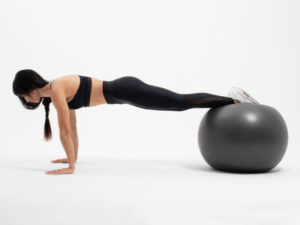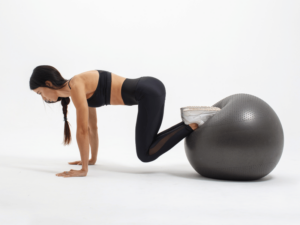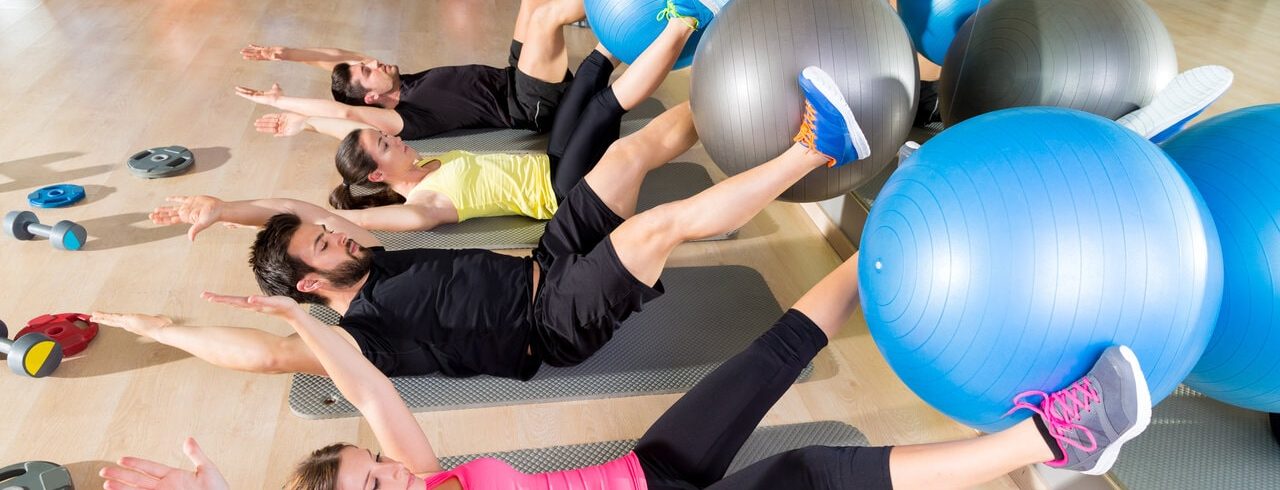Have you heard other gym buddies emphasize the importance of core training? They’re talking about the inner muscles that make up the abdominal region, hips and lower back. Most people focus their attention on the muscles that are more visible and easy to train, such as biceps, pecs and back, while the most important muscles that act as our foundation are often overlooked. So what is core training, or, better yet, core stability and what types of stability ball core exercises can you perform to improve your core?
THE IMPORTANCE OF CORE STRENGTH
Your core is a crucial component of your body and plays a big role in almost everything you do. When you take time to prioritize core exercises during your workout routines, you can benefit from:
- Better Posture: Improving your core strength can improve your spine health and overall posture. The additional spinal support will help you stand tall, reducing stress on your back and neck.
- Injury Prevention: The last thing you want to do is hurt yourself or strain a muscle at the gym. With a strong core, you can reduce your risk of injuries and evenly distribute the workload you put on your body during your workouts, preventing unwanted injuries in and outside of the gym.
- Protect Your Lower Back: Struggle with lower back pain? We have good news for you. Core exercises with a ball are a great preventative care exercise that can help protect your lower back.
- Enhanced Stability: Keeping your core muscles engaged during workouts is vital to stabilizing the muscles in your body and improving your overall balance. This means making stability ball core exercises part of your weekly workout routine will help you confidently take on those one-leg exercises, yoga poses and planks.
- Improved Athletic Performance: Want to run faster, jump higher and lift heavier? It’s time to start prioritizing your core workouts. Core strength can reduce fatigue and improve your endurance, getting you one step closer to reaching your goals in the gym.
In other words, a strong core makes for a strong body, so how do you train this essential group of muscles? One of the best tools is a stability ball.
WHAT IS A STABILITY BALL?
No, that big round bounce ball in the gym isn’t for fun and games. It’s actually called a stability ball! Once used as a tool for rehabilitation, stability balls have now become a hot item to use for core and stability training. While it may not seem challenging at first glance, stability ball core exercises challenge several different muscle groups at once, providing a killer workout you’ll definitely feel in the morning.
Stability balls can be used in a variety of settings: used with bodyweight only, integrated with selectorized machines and free weights, or used with free weight or tubing exercises. They also come in a variety of sizes and can be used to target your core muscle group, as well as improve your balance and flexibility.
To get the most out of stability ball core exercises – you’ll want to practice slow, controlled movements and keep your core engaged. Only move at a pace your body is comfortable with, and practice controlled breathing throughout each rep.
SAFETY PRECAUTIONS
Stability ball ab exercises can be relatively safe and easy to incorporate into your gym sesh. However, there are safety precautions to take when incorporating new workouts into your routine.
Here’s what you need to know:
- Consider the Size: Stability balls come in a variety of sizes. When choosing which exercise ball is best for you, you’ll want to consider your height and weight. If the ball is too small, you may struggle to stay stabilized on the ball. If you aren’t sure which size exercise ball is best for you, don’t be afraid to ask a Team Member or Personal Trainer.
- Start With Easy Exercises: While core exercises with a ball might seem easy – they can be more challenging than you think. You’ll want to start with basic exercises to ensure you have proper form and technique. The more comfortable you get, the more you can challenge yourself later.
- Practice Controlled Movements: When incorporating stability ball core exercises in your routine, there is no reason to speed through your reps or go too quickly. You could strain a muscle or injure yourself if you lose your stability, especially while sitting on the ball. Instead, you’ll want to focus on slow, controlled movements.
- Pay Attention to Your Body: Trust us – if you’re doing it right, your muscles will start to burn. However, if this burning sensation is causing pain or discomfort, your body may be telling you to slow down or take a break.
No matter what stability ball exercises you incorporate into your routine, always listen to your body and gradually work your way into the workout. This will reduce your risk of injury, strained muscles or discomfort.
TOP STABILITY BALL CORE EXERCISES FOR BEGINNERS
Never used a stability ball before? Not a problem. You don’t need to be a professional gymnast to get the hang of stability ball core exercises. Start with these three stability ball core exercises for beginners.
1. STABILITY BALL CRUNCH

The simplest core stability ball exercise is also one of the most effective. Lie across the stability ball with the ball under your hips and lower back. Place both feet squarely on the ground. Lace your hands behind your head and perform crunches. You should feel the burn in your upper abs. Try not to pull on your neck with your hands or let the ball move beneath you. Tip: If the ball feels unstable, position yourself so that your feet are against a wall.
2. STABILITY BALL RUSSIAN TWIST
Start in the same position as the crunch, but instead of crunching forward, crunch up and then slowly twist your body from side-to-side. You should feel the burn on the sides of your abs, known as your obliques.
3. STABILITY BALL PLANK

Get ready to feel the burn. Carefully place the tops of your feet on the stability ball. Hold yourself up on your hands or elbows. Keep your pelvis tucked and your abs tight. Focus on maintaining a straight back and resist the urge to stick your glutes in the air. Try to hold the plank for at least 30 seconds. If the ball starts to roll, move it higher on your legs.
To perform another version of this exercise, switch sides. That is, you place your forearms on the stability ball and your feet on the ground. Keep your abs tight to stabilize your body and prevent the ball from moving.
TOP INTERMEDIATE STABILITY BALL EXERCISES
Want to push your stability ball training to the next level? Once the beginning exercises start to feel easy, and you become more confident in your body awareness and balance, give these intermediate core stability ball exercises a try.
1. STABILITY BALL BICYCLE CRUNCH
Start in the position you would use to perform a stability ball crunch, with the stability ball under your lower back and your feet planted on the ground. Crunch up and twist with your upper body while bringing your opposite knee to your opposite elbow, as close together as possible. Lower yourself back down to the starting position and repeat on the other side.
2. STABILITY BALL KNEE TUCK

Start in the same position as the stability ball plank, with your hands on the ground and your feet on the stability ball. Using your core, pull your knees towards your hands, allowing the ball to roll towards you. To get the most out of this movement, really focus on contracting your abs to tuck your knees instead of using your shoulders or quads. Keep your glutes down as much as possible during this movement.
3. STABILITY BALL HANDS-TO-FEET PASS

Start by lying on the ground on your back. Position the stability ball between your feet. Pressing your feet together and tightening your abs, lift the stability ball with your feet while crunching up. At the top of the movement, take the stability ball from your feet with your hands. Slowly, lower yourself back down, with your arms outstretched. Touch the ball on the ground behind your head, then crunch up again. This time you are passing the ball from your hands to your feet. This is a very challenging stability ball core exercise. Try to maintain slow, controlled movement and keep your back flat on the floor.
STABILITY CORE EXERCISES WITH WEIGHTS
Want to make a stability ball core exercise even more challenging? Add weight into the mix. Not every exercise can incorporate weights, but many can. For example, grab a dumbbell, weight plate, or kettlebell and clutch it to your chest during stability ball crunches or stability ball Russian twists. Add a weight plate to your back or wear a weight vest during your stability ball planks. You can even hold a weight plate in your hands and the stability ball between your feet as you perform weighted v-ups.
Stability ball exercises with weights are typically advanced movements that require comfort with the underlying exercise. Beginners and intermediate exercisers should focus on simply working out with the stability ball before attempting a movement with weights.
OTHER CORE TRAINING TOOLS
Stability balls aren’t the only tool you can use to train in an unstable environment. Core boards, wobble boards, foam rollers and discs can all play a vital role in improving your athletic performance and training in a way that readily translates to real-life activities.
No matter what you are trying to accomplish, adding core training to your fitness routine is important. Thinking about all the components you need to integrate into your fitness, including muscle strength and endurance, cardiovascular, flexibility, stability/balance and coordination, it may seem as though there is not enough time in the day to do it all. This is where the professional assistance of a Personal Trainer comes into play. A Personal Trainer will be able to set up a program that is customized to your needs, wants and lifestyle so that you don’t spend hours in the gym if that’s not your goal. After all, many of us work out so that our life outside the gym is more enjoyable.
HOW EōS FITNESS CAN SUPPORT YOU
Ready to strengthen your core and incorporate stability ball exercises into your workout routine? EōS Fitness is here to help. If you like Group Fitness Classes, we recommend trying one of our Strength and Core Group Fitness Classes.
Our Rock Hard Abs and Define & Align Classes are designed to help you keep your core engaged while helping you achieve the results you’re looking for! Many of these classes will include stability ball ab exercises, so this is a great opportunity to test the waters with different exercises and practice your form and movement.
FOCUS ON YOUR CORE WITH EōS
Once you start adding stability ball exercises into your fitness routine, you’ll quickly see how it affects other activities in your life. No matter what your fitness level may be, anyone can utilize a stability ball to start training their core and improving their coordination. If you need help putting all the pieces of your fitness plan together, consider investing in a Personal Trainer at EōS Fitness.


